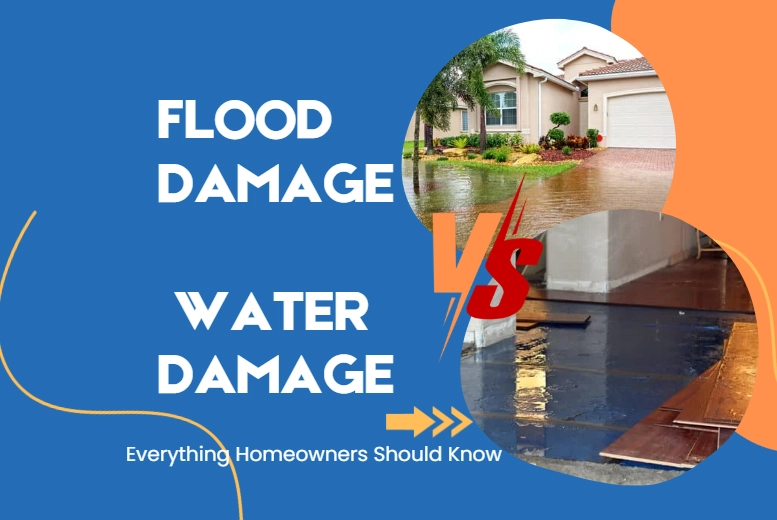When disaster strikes your home, understanding the difference between flood and water damage is crucial for effective recovery. While both can wreak havoc, their causes, insurance implications, and restoration processes can vary significantly. Flood damage typically arises from natural disasters, such as heavy rain or rising river levels, impacting a wider area and often leading to extensive destruction. On the other hand, water damage usually stems from internal issues, such as leaky pipes or appliance failures, which may be easier to manage but can still lead to serious structural concerns. Whether you’re a seasoned homeowner or navigating property ownership for the first time, grasping these distinctions equips you with the knowledge to respond swiftly and adequately when facing such challenges. Let’s dive deeper into the critical differences between flood and water damage, empowering you to safeguard your home and finances.
Understanding the Core Difference Between Flood and Water Damage
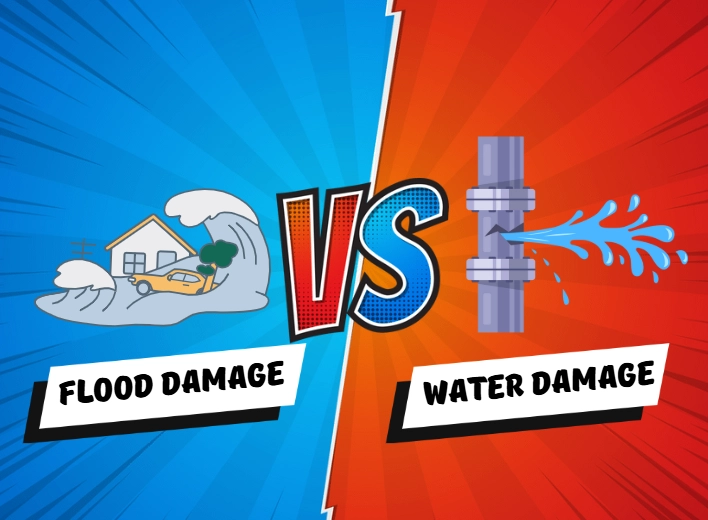
When discussing flood and water damage, it is essential to recognize that these two terms, while often used interchangeably, refer to distinct phenomena with unique causes and implications. Flood damage is generally defined as water damage caused by natural events, such as heavy rain, overflowing rivers, or hurricanes. This type of damage typically affects multiple properties within a geographical area, leading to widespread destruction. For local context, review Virginia’s seasonal causes of home flooding to see how storms, snowmelt, and surges drive risk. Floodwaters often contain contaminants, including sewage, chemicals, and debris, which can exacerbate the damage and complicate the cleanup process.
On the other hand, water damage is usually the result of internal issues within a property. Common causes include burst pipes, leaky roofs, malfunctioning appliances, or overflowing toilets. Unlike flood damage, water damage is typically localized to a single property or even a specific area within a home, making it somewhat easier to manage. However, it can still lead to significant structural damage, mold growth, and health hazards if not addressed promptly and properly.
Understanding the core differences between flood and water damage is crucial for homeowners, as it influences the steps needed for recovery, the type of insurance coverage required, and the preventive measures that can be taken to protect a property. By distinguishing between these two types of damage, homeowners can better prepare for potential disasters and respond more effectively when they occur.
Common Causes of Flood Damage
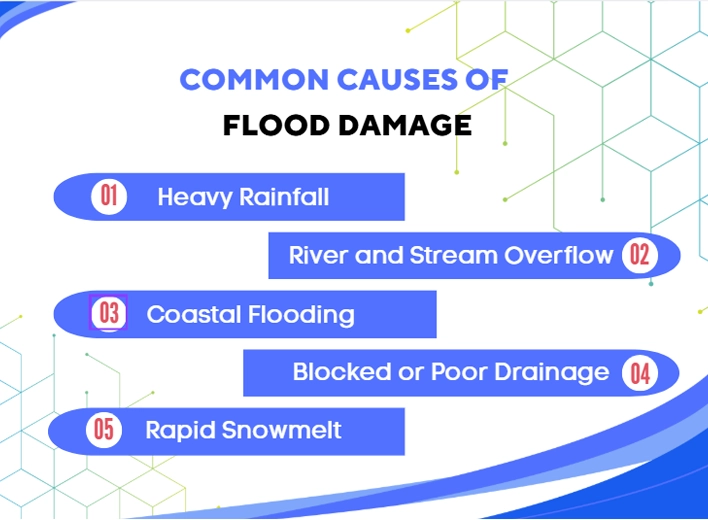
Flood damage can strike suddenly, leaving homes and businesses vulnerable to costly repairs. Understanding the most common causes helps property owners take preventive measures and respond quickly to minimize long-term damage.
1. Heavy Rainfall
Intense or prolonged rainfall can overwhelm drainage systems, causing water to accumulate in streets and low-lying areas. This type of flooding often results in property damage, erosion, and disruption to daily life, emphasizing the importance of proper drainage management.
2. River and Stream Overflow
Rivers, streams, and lakes can overflow due to excessive precipitation, snowmelt, or dam failure. The rising water can flood nearby areas, damaging homes, infrastructure, and landscapes while posing serious risks to residents and the environment.
3. Coastal Flooding
Storm surges from hurricanes, tropical storms, or tsunamis can inundate coastal areas. Homes and businesses near the shore are particularly vulnerable, facing structural damage, erosion, and long-term economic impacts from severe flooding events.
4. Blocked or Poor Drainage
Clogged storm drains, sewers, or gutters can exacerbate flooding during heavy rains. Water accumulation from poor drainage can lead to localized flooding, property damage, and mold growth if not addressed promptly.
5. Rapid Snowmelt
Sudden melting of snow, often combined with rainfall, can overwhelm rivers and drainage systems. Rapid snowmelt increases the risk of flash floods, threatening properties and requiring immediate mitigation efforts.
Common Causes of Water Damage Inside the Home
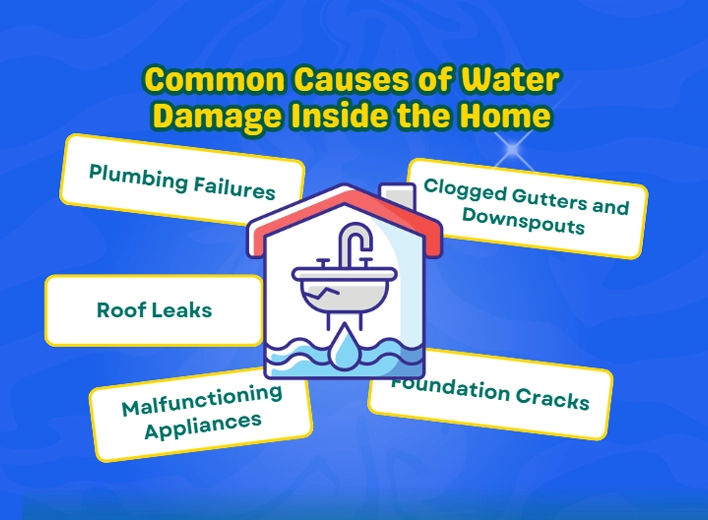
Water damage inside the home can happen unexpectedly, leading to costly repairs and potential health hazards. Understanding the main causes helps homeowners take preventive measures and respond quickly to protect their property and belongings.
1. Plumbing Failures
Burst or leaking pipes are a leading cause of indoor water damage. Aging pipes, freezing temperatures, or poor installation can result in leaks that damage walls, floors, and personal items, making timely detection and repair essential.
2. Roof Leaks
Damaged or poorly maintained roofs allow rainwater to seep into your home, affecting ceilings, insulation, and electrical systems. Promptly addressing roof leaks prevents further structural damage and protects your home from extensive interior water damage.
3. Malfunctioning Appliances
Appliances like washing machines, dishwashers, and water heaters can release large amounts of water when they fail. If flooring is affected, follow our tile and floor cleanup after water damage steps. Regular maintenance and timely repairs reduce the risk of flooding and protect your home from costly water damage incidents.
4. Clogged Gutters and Downspouts
Improperly maintained gutters can cause rainwater to overflow and seep into walls or foundations. Regular cleaning ensures proper water drainage, preventing water accumulation and protecting your home from structural damage.
5. Foundation Cracks
Cracks in the foundation allow groundwater to enter basements or crawl spaces, leading to flooding, mold growth, and structural issues. Inspecting and sealing foundation cracks is vital for long-term water damage prevention.
How Flood and Water Damage Impact Your Home Differently
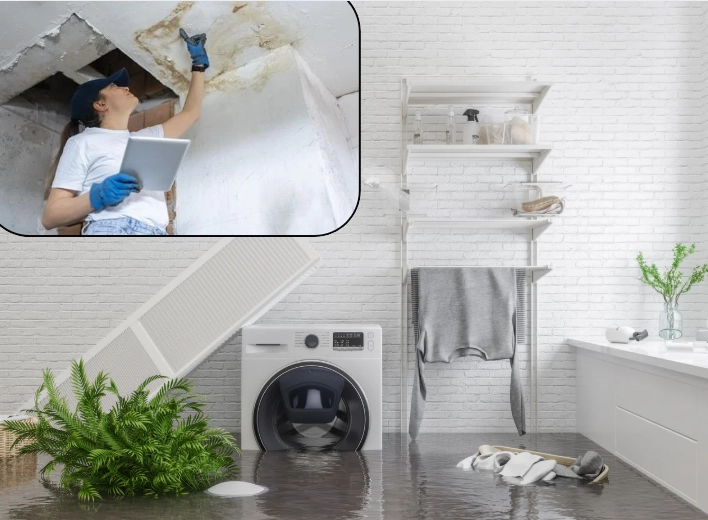
Flood and water damage, while both devastating, impact homes in different ways. Flood damage typically affects a larger area and can be more severe due to the volume and contamination of the floodwaters. Floodwaters often carry pollutants, including sewage, chemicals, and debris, which can pose serious health risks and complicate the cleanup process. Additionally, the force of moving water during a flood can cause structural damage to homes, including foundation erosion, wall collapse, and roof damage. Here’s what to expect during home restoration so you can plan the next steps.
In contrast, water damage from internal sources, such as plumbing failures or appliance malfunctions, is usually more contained but can still cause significant harm. Water damage inside the home can lead to the deterioration of building materials, such as wood, drywall, and insulation. Prolonged exposure to water can weaken these materials, compromising the structural integrity of the home. Furthermore, water damage can create a conducive environment for mold growth, which can pose health risks and further damage the property.
Another key difference between flood and water damage is the speed at which they occur. Flood damage can happen rapidly, often within hours or even minutes, leaving little time for homeowners to take preventive measures. On the other hand, water damage from internal sources may develop more slowly, providing an opportunity to detect and address the issue before it becomes a major problem. However, both types of damage require prompt attention to mitigate their effects and prevent long-term consequences.
Insurance Coverage: Flood Damage vs. Water Damage
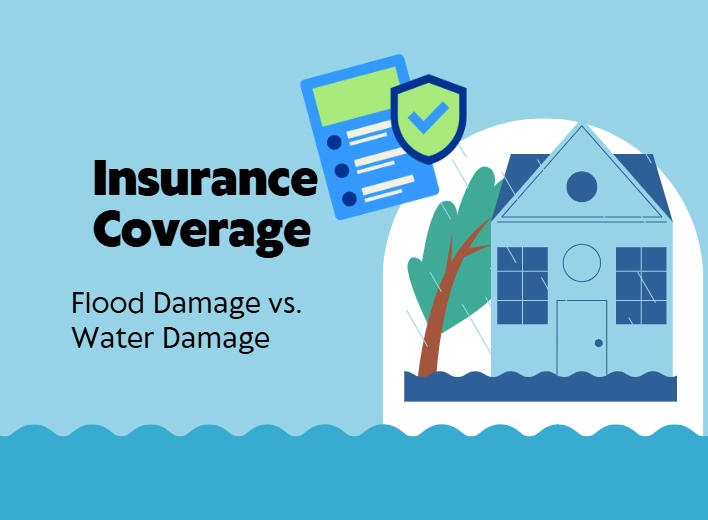
Understanding the differences in insurance coverage for flood and water damage is crucial for homeowners. Standard homeowners insurance policies typically do not cover flood damage. For details on claims and exclusions, see does homeowners insurance cover flood cleanup? Instead, homeowners need to purchase separate flood insurance policies through the National Flood Insurance Program (NFIP) or private insurers. Flood insurance covers damage to the structure of the home and its contents caused by flooding events, such as heavy rain, overflowing rivers, or storm surges.
In contrast, standard homeowners insurance policies generally cover water damage caused by sudden and accidental incidents, such as burst pipes, appliance malfunctions, or roof leaks. This coverage typically includes the cost of repairing or replacing damaged structures and personal belongings, as well as the expenses for temporary housing if the home is uninhabitable. However, it’s important to note that gradual water damage resulting from poor maintenance or neglect is usually not covered by insurance.
Given the distinct differences in coverage, it is essential for homeowners to review their insurance policies carefully and understand the specific terms and conditions. Additionally, homeowners should consider their property’s location and susceptibility to flooding when deciding whether to purchase flood insurance. Being adequately insured for both flood and water damage can provide peace of mind and financial protection in the event of a disaster.
Preventive Measures to Avoid Flood and Water Damage
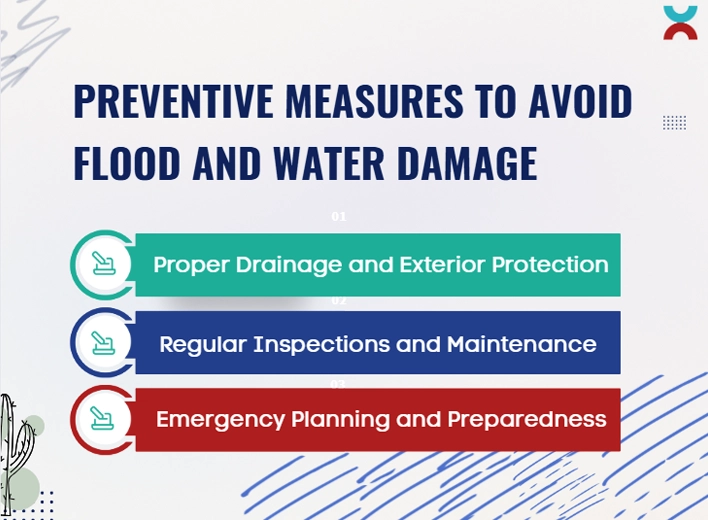
Being proactive is the best way to protect your home from costly and disruptive water-related issues. With the right preventive strategies, homeowners can significantly reduce the risk of both flooding and water damage while safeguarding their property and loved ones.
1. Proper Drainage and Exterior Protection
Effective drainage around your property is one of the most important defenses against flooding. Keeping gutters and downspouts clear of debris ensures water flows freely and is directed away from your foundation. Extending downspouts and grading the soil properly can further prevent water from pooling near the home. Installing a sump pump in the basement adds another layer of protection, especially during heavy rains or flooding events.
2. Regular Inspections and Maintenance
Routine checks inside and outside the home can prevent water damage before it becomes severe. Inspect plumbing for leaks, examine the roof for missing or damaged shingles, and ensure that household appliances are functioning properly. Adding water leak detection devices provides early alerts of hidden leaks, while insulating pipes helps protect against freezing and bursting during colder months.
3. Emergency Planning and Preparedness
Even with strong preventive measures, emergencies can still occur, which is why having a plan is crucial. Homeowners should know how to shut off the main water supply and have clear steps for contacting emergency services or evacuating if necessary. Preparing an emergency kit with essentials such as flashlights, batteries, bottled water, and first aid supplies ensures readiness for sudden flood or water damage situations.
Conclusion: Protecting Your Home from Water-Related Issues
Understanding the difference between flood and water damage is essential for homeowners to effectively protect their property and respond to emergencies. While both types of damage can be devastating, their causes, insurance implications, and restoration processes differ significantly. By recognizing these distinctions, homeowners can take proactive measures to prevent damage, ensure they have the appropriate insurance coverage, and respond swiftly when disaster strikes.
Implementing preventive measures, such as maintaining proper drainage, conducting regular inspections, and creating an emergency plan, can significantly reduce the risk of flood and water damage. Additionally, knowing when to call professional restoration experts is crucial to ensure the property is properly cleaned and restored, minimizing long-term risks and health hazards. If you’re dealing with an active leak or overflow, contact us for professional water damage restoration.
Ultimately, being informed and prepared empowers homeowners to safeguard their homes and finances from the devastating effects of flood and water damage. By taking proactive steps and staying vigilant, homeowners can protect their property, ensure their family’s safety, and maintain peace of mind in the face of water-related challenges.

